Koi Parasites and Their Treatments
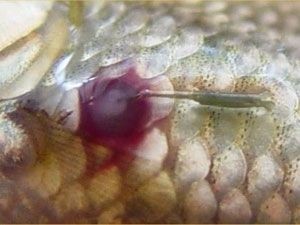
Anchor worm or Lernaea is a common parasite on Koi. It is one of the only parasites that is visible to the naked eye and can reach 1/2 inch in length. Typically the parasite will burrow its head into the Koi's tissue under a scale and only the body and tail will be visible. The juvenile stages settle in the gills of Koi, when they mature they mate and the male leaves the Koi, the fertilized female settles on the body of the Koi and continues to grow, becoming the familiar worm shape. The female buries into the skin and underlying tissue to hold on. The damage caused can become a target for bacterial or fungal infection which can spread. Lernaea lay eggs which can lay undetected in the pond and can hatch when conditions and water temperatures are right. Treatment is by manual removal of the parasite with tweezers under anesthetic, ensuring that the whole parasite is removed. To be sure of complete removal, dip a cotton bud in strong potassium permanganate solution and dab the worm with this solution whereupon it will release its grip immediately.
.
.
.
.
.
Carp Pox and its Treatment
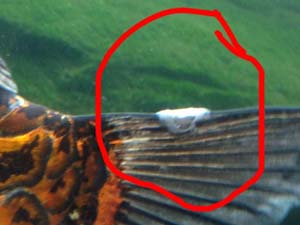
A virus that produces solid waxy lumps on Koi. It will not kill Koi and is generally harmless, but can look unsightly. It is most often present in small Koi and in cold weather. It usually starts disappearing in the spring when water temperatures rise. Normally we do not do any type of treatment for this. In most cases after a ki has had it one time it will not get it again much lick chicken pox in humans.
.
.
.
.
.
.
.
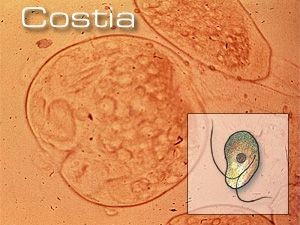 Costia is a minute Flagellate with 3-4 flagella. It affects both the skin and gills of Koi, and reproduces itself by binary fission. Infestations of this parasite can appear very rapidly indeed, and Koi suffering infestations exhibit the classic symptoms of lethargy, clamped fins, rubbing and flashing and the skin can take on a grey white opaqueness.
Costia is a minute Flagellate with 3-4 flagella. It affects both the skin and gills of Koi, and reproduces itself by binary fission. Infestations of this parasite can appear very rapidly indeed, and Koi suffering infestations exhibit the classic symptoms of lethargy, clamped fins, rubbing and flashing and the skin can take on a grey white opaqueness.
Costia normally only affects fish that have already been debilitated by some other cause, and can often be seen on Koi as a secondary parasite. A high magnification must be used to view these parasites (300 x) and staining is recommended for positive identification.
.
.
.
.
.
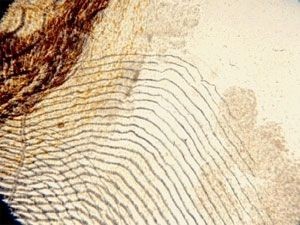
Often mistaken for a fungal infection because of its mold-like lesions, Columnaris is a common bacterial infection in cultured fish, particularly livebearing fish and catfish. Its name is derived from columnar shaped bacteria, which are present in virtually all pond environments.
The bacteria are most likely to infect fish that have been stressed by such conditions as poor water quality, inadequate diet, or handling and shipping. Columnaris can enter the fish through the gills, mouth, or via small wounds on the skin. The disease is highly contagious and may be spread through contaminated nets, specimen containers, and even food. Treatment with anti bacterial medicine is usually effective.
.
.
.
Dropsey and its Treatment
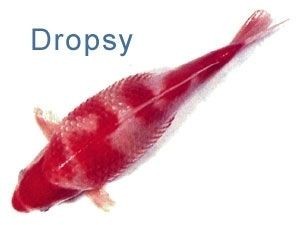
Raised scales (rather like a pine cone) and eyes standing out from the head.
Dropsy itself is not a disease, but rather a result of some other cause. Dropsy is a term given to the swelling that occurs internally in the fish. There are multiple possible causes. Sometimes it's not contagious, but sick fish should be isolated and treated since determining the actual cause may be impossible, and also because this will be easier on the fish.
The fish's body will become swelled with fluid it is unable to expel. Eventually the swelling will cause the scales to raise, giving the fish what is called the "pine-cone" appearance.
Diagnosis, One of these situations may be the cause:
- Sudden swelling: A bacterial infection will cause internal bleeding.
- Slow swelling: Growing tumors, or even parasites, in the fish may cause it to swell.
- Slow swelling: Mycobacterium tuberculosis. Highly contagious!
Bacterial dropsy is infectious so treat with an anti bacterial remedy and if possible isolate affected Koi. When we get a koi with Dropsey here we put them down.
.
.
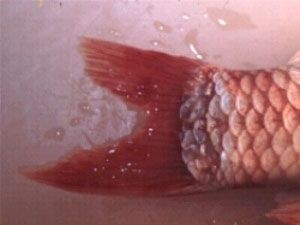 A number of bacteria are associated with finrot, lesions and internal hemorrhaging, notably Aeromonas and Pseudomonas. Ulcers usually start at the site of an injury, the bacteria then infect it causing further damage, and fungal infection can also occur. Such holes result in osmoregulatory problems, leading to damaged kidneys and death if not treated. It is worth adding a weak salt solution to the pond as well as anti bacterial remedy, a concentration of 3gm per litter will help to restore the osmotic balance and reduce strain on the kidneys (make sure that the salt is fully dissolved before you add it to the pond). Finrot is easily noticeable, the fins and/or tail look chewed and are red at the edges. Secondary bacterial and fungal infections can develop.
A number of bacteria are associated with finrot, lesions and internal hemorrhaging, notably Aeromonas and Pseudomonas. Ulcers usually start at the site of an injury, the bacteria then infect it causing further damage, and fungal infection can also occur. Such holes result in osmoregulatory problems, leading to damaged kidneys and death if not treated. It is worth adding a weak salt solution to the pond as well as anti bacterial remedy, a concentration of 3gm per litter will help to restore the osmotic balance and reduce strain on the kidneys (make sure that the salt is fully dissolved before you add it to the pond). Finrot is easily noticeable, the fins and/or tail look chewed and are red at the edges. Secondary bacterial and fungal infections can develop.
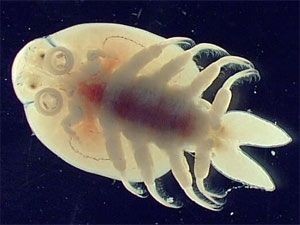 Argulus another crustacean parasite, round and up to 1cm wide. They have a sucker to hold on to the Koi with needle-like mouth parts which they stick into the Koi and inject a toxin. This causes intense irritation to the Koi and they scratch and jump and can cause bacterial infection. If they infect the gills they cause severe damage and often death.
Argulus another crustacean parasite, round and up to 1cm wide. They have a sucker to hold on to the Koi with needle-like mouth parts which they stick into the Koi and inject a toxin. This causes intense irritation to the Koi and they scratch and jump and can cause bacterial infection. If they infect the gills they cause severe damage and often death.
.
.
.
.
.
.
.
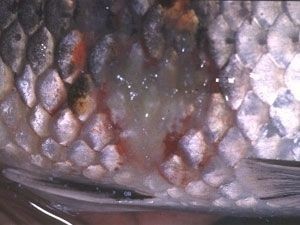 One of the most common fungal infections of Koi. The fungal spores will grow anywhere on the Koi, including the gills, initially germinating on dead tissue. Their threadlike hyphae release digestive juices which break down the tissue so the fungus can absorb it, as the fungus grows these juices start breaking down living tissue. Fungus on the body appears as cotton wool like growths, it is hard to tell if a Koi has it in the gills, but if it hangs at the surface gulping for air it is likely.
One of the most common fungal infections of Koi. The fungal spores will grow anywhere on the Koi, including the gills, initially germinating on dead tissue. Their threadlike hyphae release digestive juices which break down the tissue so the fungus can absorb it, as the fungus grows these juices start breaking down living tissue. Fungus on the body appears as cotton wool like growths, it is hard to tell if a Koi has it in the gills, but if it hangs at the surface gulping for air it is likely.
.
.
.
.
.
.
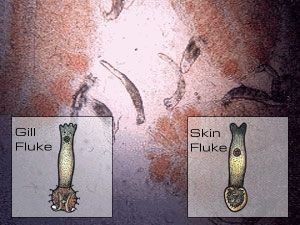 Gill and Skin flukes are two of the family of monogenetic trematode genera, all of which are characterised by the large grappling hooks which are used to attach themselves to their victims. Flukes are another common parasite affecting our koi are both egg layers and live bearers. They range from 0.05 to 3.00mm long and there are actually a huge number of species in the genus. Affected Koi often exhibit classic signs of irritation and flash, jump or rub themselves against objects in the pond in an attempt to rid themselves of their attackers. Flukes are not visible with the naked eye. When viewed under a microscope, the parasites are clearly visible as nearly transparent and worm like, and the hooks are clearly visible. Flukes are a bit like fleas on dogs and cats and it is common to see one or two on a slide as a healthy Koi can control parasite numbers and their mucus helps prevent the parasite moving. Treatment is therefore only necessary if flukes are seen in numbers. We recommend using Praziquantel for treating Flukes. The real bonus with Praziquantel is that when you treat for flukes, it also rids the fish of any internal parasites or worms.
Gill and Skin flukes are two of the family of monogenetic trematode genera, all of which are characterised by the large grappling hooks which are used to attach themselves to their victims. Flukes are another common parasite affecting our koi are both egg layers and live bearers. They range from 0.05 to 3.00mm long and there are actually a huge number of species in the genus. Affected Koi often exhibit classic signs of irritation and flash, jump or rub themselves against objects in the pond in an attempt to rid themselves of their attackers. Flukes are not visible with the naked eye. When viewed under a microscope, the parasites are clearly visible as nearly transparent and worm like, and the hooks are clearly visible. Flukes are a bit like fleas on dogs and cats and it is common to see one or two on a slide as a healthy Koi can control parasite numbers and their mucus helps prevent the parasite moving. Treatment is therefore only necessary if flukes are seen in numbers. We recommend using Praziquantel for treating Flukes. The real bonus with Praziquantel is that when you treat for flukes, it also rids the fish of any internal parasites or worms.
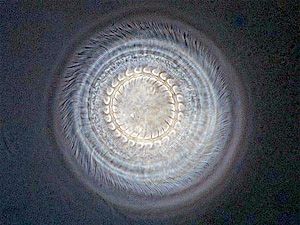 Trichodina is one of the easiest protozoan parasites to detect under the microscope as it is almost perfectly round with hundreds of hooks which resemble cilia found its periphery and it constantly rotates as it moves through the mucus, causing tissues damage. It attacks both skin and gill tissues of our Koi, and can often cause more damage to gills than realized. Classed as a warm water parasite, it can survive for some time without a host. It causes vegetation of the skin giving rise to a grey white opaque appearance on the body of infected Koi which exhibit the classic symptoms of flashing, rubbing and lethargy. A magnification of 100 to 200 x is required to view this parasite. Recommended treatments are Potassium Permanganate.
Trichodina is one of the easiest protozoan parasites to detect under the microscope as it is almost perfectly round with hundreds of hooks which resemble cilia found its periphery and it constantly rotates as it moves through the mucus, causing tissues damage. It attacks both skin and gill tissues of our Koi, and can often cause more damage to gills than realized. Classed as a warm water parasite, it can survive for some time without a host. It causes vegetation of the skin giving rise to a grey white opaque appearance on the body of infected Koi which exhibit the classic symptoms of flashing, rubbing and lethargy. A magnification of 100 to 200 x is required to view this parasite. Recommended treatments are Potassium Permanganate.
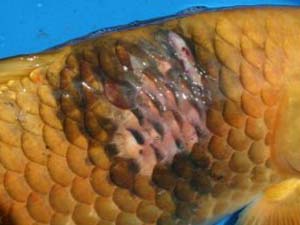 #################
#################
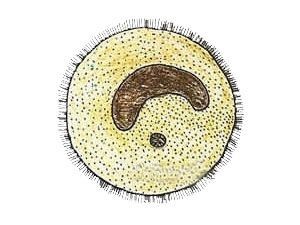 Caused by Ichthyopthirius Multifiliis. The white spots on the skin, gills and fins are individual protozoan cells that are under the skin and feed on the body fluids and cells. They then punch out of the skin and fall to the bottom of the pond, collect together and begin breeding, the offspring then re-invest the fish. As well as white spots symptoms are scratching and swimming into the water inlet, failure to feed and lethargy. It is fatal if untreated. Fortunately commercial white spot remedies are widely available.
Caused by Ichthyopthirius Multifiliis. The white spots on the skin, gills and fins are individual protozoan cells that are under the skin and feed on the body fluids and cells. They then punch out of the skin and fall to the bottom of the pond, collect together and begin breeding, the offspring then re-invest the fish. As well as white spots symptoms are scratching and swimming into the water inlet, failure to feed and lethargy. It is fatal if untreated. Fortunately commercial white spot remedies are widely available.


